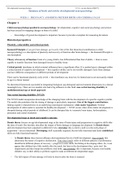Summary
Summary Developmental Neuropsychology books, articles and primers (except CP primer)
- Course
- Institution
- Book
Summary of all the course material of Developmental Neuropsychology for the master Cognitive Neuropsychology. All books, articles and primers are summarized. Only the CP primer is not summarized, because I did not understand this one (sorry).
[Show more]




